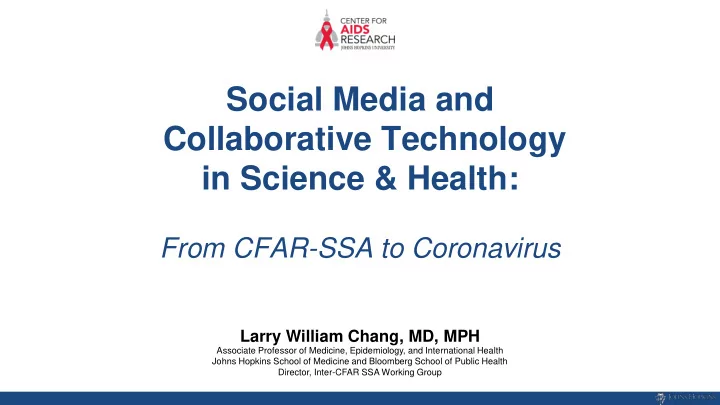

Social Media and Collaborative Technology in Science & Health: From CFAR-SSA to Coronavirus Larry William Chang, MD, MPH Associate Professor of Medicine, Epidemiology, and International Health Johns Hopkins School of Medicine and Bloomberg School of Public Health Director, Inter-CFAR SSA Working Group
Disclosures • I have a financial interest in emocha Health Inc. which I helped found and does work related to this topic.
CFAR-SSA
CFAR-SSA • The Inter-CFAR Sub-Saharan Africa Working Group is composed of CFAR- affiliated investigators (US and SSA-based) interested in HIV research in SSA. • Established in 2011 • CFAR-SSA Goals: 1. Capacity Build Junior SSA Investigators 2. Promote New Collaborative Research Opportunities
CFAR-SSA Activities/Resources • International Mtgs – Kampala (UCSF), Cape Town (Hopkins), Durban (Brown/Harvard), Nairobi (UW) – Next Meeting IAC 2020 San Francisco/Oakland (Led by UCSF) ??? • Listserv: ~693 members – https://groups.google.com/group/CFAR-SSA • Facebook Group – www.facebook.com/groups/cfarssa/ • Website: resources, links, presentations – www.hopkinscfar.org
How do we use social media and technologies to build research collaborations and community? (and respond to a public health emergency)
Social Media & Technology Tools
Listservs • Listserv -an electronic mailing list • In 1986, Éric Thomas developed “Revised Listserv”, the first automated mailing list management application. • Simple • Asynchronous • Awkward for discussion • Moderator needed • How to – Google Groups – Any email service Wikipedia; http://www.lsoft.com/corporate/history-listserv.asp
Facebook • Facebook Groups • FB reach itself is high but group participation can be low. • Needs moderation and basal activation energy.
Websites • Range – Mostly static reference point, e.g. most academic sites – Dynamic, constantly updating, e.g. news sites, epidemic mapping, etc. • Searchable -thus often necessary as a point of contact • Cons -needs moderation and upkeep https://covid-19.uwmedicine.org/Pages/default.aspx
Whatsapp • Messaging/calling app • 2 billion active users • Owned by Facebook • End-to-end encryption • Phone, Desktop, & Web • Simple, Powerful • Nothing with greater reach • Examples: – CROI discussion group – Virtual journal club Facebook Messenger similar Lin and Sherbino J Grad Med Educ. 2015
Twitter • Microblog & Social Network Tool • 280 character limit • Nothing with more immediate scientific/public health reach to the public. • What is on Twitter today, becomes the news headline of tomorrow. Learn More About Twitter Here Twitter for Researchers from the Emory CFAR
Reddit • A “social news aggregation, rating, and discussion website” • 5 th most visited website in U.S.
Youtube • If you have video content, a logical place to share. • Create a channel • Add subscribers • Videos are public, unlisted, or private.
Instagram, TikTok, Snapchat, etc. • Lots more out there • Know your audience
Communications Software: The Rise of Zoom • Communications Software – Talk – Video – Chat – Share Screen https://www.owllabs.com/state-of-video-conferencing
Collaboration Software • Typically combines chat, application integration, and file storage. • Searchable and a living history of a project. • Everyone must learn and commit. • Desktop, Phone, Web
Google Docs, Sheets, Slides • Free, web-based software c collaboration tools Politico.com; covidtracking.com
How else does this play out in the Real-World?
Telemedicine nytimes.com; Suzuki et al. Health Policy Technology 2020.;NEJM 2020.
Teleresearch, Online Research Sciencemag.org; David Boulware UMN; NIH
Travel Bans
Africa, Coronavirus, and HIV Research • Studies have/will close. • Travel will be limited. • HIV and Coronavirus? • Epidemic dynamics could be quite different • How do CFARs stay engaged? Gilbert et al. Lancet 2020.
The Online Writing Accountability Group (WAG) • Fogarty D43 Activity • WAGs – Small group – Commit to meeting regularly – Dedicate time to writing
Virtual Meetings • CFAR Webinar!!! • Cons – Q&A – Networking – Serendipity • How to recreate in-person interactions? ???
Sharing Data experience.arcgis.com/experience/7e30edc490a5441a874f9efe67bd8b89; www.rhsp.org
Phylogenetics Nextstrain.org/ncov
Mapping Data • 1 billion usage requests per day Dong et al. Lancet ID 2020.
Maps and Smart Devices https://healthweather.us/
Smartphone Surveillance www.nytimes.com/2020/03/01/business/china-coronavirus-surveillance.html; https://www.cnn.com/2020/03/20/tech/quarantine-privacy-coronavirus/index.html
Garbage In, Garbage Out
Tips As We Go Virtual • Turn on your video when you can • The most important button is the mute button • Don’t assume you are muted • Learn & experiment with the new technologies • Brush up on conference call etiquette • Get good equipment (camera, microphone/speaker, green screen, etc.) • Empathy & Awareness Gillian Steinberg
Thank you! Gary Larson
Recommend
More recommend